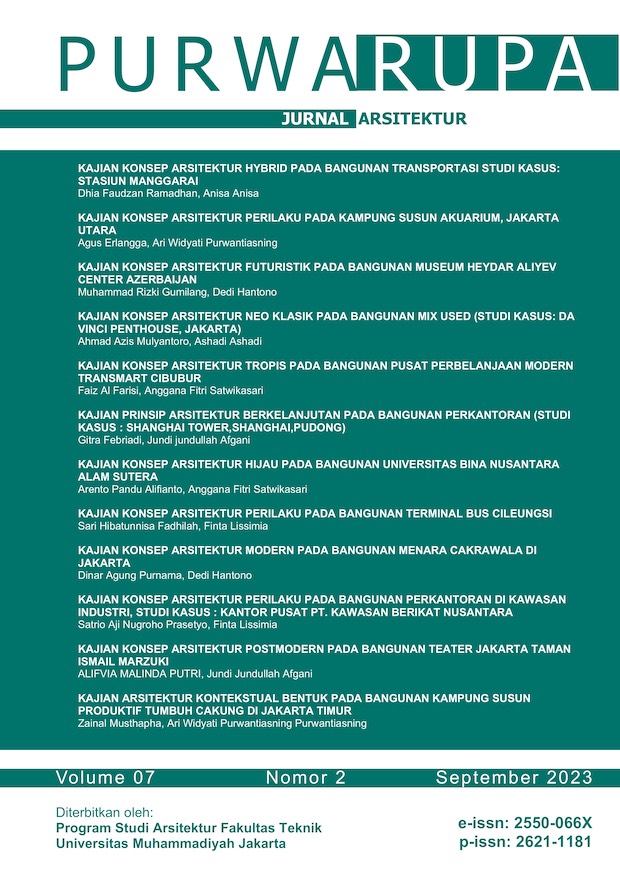KAJIAN KONSEP ARSITEKTUR TROPIS PADA BANGUNAN PUSAT PERBELANJAAN MODERN TRANSMART CIBUBUR
DOI:
https://doi.org/10.24853/purwarupa.7.2.31-36Abstract
ABSTRAK. Indonesia merupakan negara yang memiliki iklim tropis. Iklim tropis terdiri atas musim kemarau dan musim hujan. Di wilayah tropis memiliki suhu yang lumayan panas dan juga meiliki curah hujan yang tinggi sehingga hal ini dapat berdampak pada bentuk adaptasi bangunan di wilayah tropis. Salah satu bangunan yang lumayan penting pada era modern ini adalah Pusat Perbelanjaan atau Mall yang menjadi tempat transaksi dan jual beli. Untuk membuat sebuah mall juga harus memperhatikan kenyamanan terutama di iklim tropis sehingga dibutuhkan kajian mengenai arsitektur modern di bangunan Pusat perbelanjaaan. Penelitian ini bertujuan untuk mengetahui ddan memahami tentang konsep arsitektur tropis pada bangunan Mall. Metode yang digunakan dalam penelitian ini adalah metode deskriptif kualitatif dengan studi kasus Transmart Cibubur. Hasilnya Transmart Cibubur terdapat sebuah kanopi dan double façade pada muka bangunan, untuk menciptakan sistem penghawaan yang menyilang dilakukan dengan menerapkan dua bukaan pada sisi bangunan terdapat pula void untuk penghawaan. Kata Kunci: arsitektur, mall, tropisABSTRACT.. Indonesia is a country that has a tropical climate. The tropical climate consists of a dry season and a rainy season. In the tropics, the temperature is quite hot and also has high rainfall, so this can have an impact on the adaptation of buildings in the tropics. One of the buildings that is quite important in this modern era is the Shopping Center or Mall which is the place for transactions and buying and selling. To make a mall you also have to pay attention to comfort, especially in a tropical climate, so you need a study of modern architecture in shopping center buildings. This study aims to find out and understand the concept of tropical architecture in Mall buildings. The method used in this study is a qualitative descriptive method with a case study of Transmart Cibubur. As a result, Transmart Cibubur has a canopy and double façade on the front of the building. To create a cross ventilation system, it is done by applying two openings on the sides of the building, there are also voids for ventilation.Keywords: architecture, mall, tropicalReferences
Nuryadi, Arief. (1995). SHOPPING MALL SEBAGAIPUSAT PERBEIANJAAN, REKREASI DAN INFORMASI DI CIIACAP. Jurnal UII
Basuki, A. (2013, November 3). Ventilasi Pada Bangunan. From Department of Civil Engineering: https://sipil.ft.uns.ac.id/?p=888
Brown, G. (1987). Matahari, Angin Dan Cahaya
Irfandi. (2009). Pengaruh Iklim Dalam Perancangan Arsitektur
Mn, L. H. (2009). PENGUDARAAN SILANG PADA PENGEMBANGAN
Suptandar, P. (1982). Aspek Pencahayaan Dalam Interior Design
Downloads
Published
Issue
Section
License
COPYRIGHT POLICY
The author(s) of an article published in the Jurnal Teknologi retains ownership of the intellectual property rights in work (s).
PUBLISHING RIGHTS
The author(s) of an article published in the Jurnal Teknologi have unrestricted publication rights. The authors give the Jurnal Teknologi the right to publish the article and designate the Faculty of Engineering Universitas Muhammadiyah Jakarta Publishing as the original publisher of the article.
LICENSING POLICY
Journal of Mechanical Engineering and Sciences is an open-access journal that follows the Creative Commons Non-Commercial 4.0 International License (CC BY-NC 4.0), which states that:

Under this license, the reusers must give appropriate credit, provide a link to the license, and indicate if changes were made. Users may do so in any reasonable manner, but not in any way that suggests the licensor endorses users or their use.
Please take the time to read the whole license agreement (https://creativecommons.org/licenses/by-nc/4.0/). As long as reusers follow the license conditions, the owner cannot withdraw these freedoms. The following components are included under this license:
 Attribution: Users must provide appropriate attribution, including a link to the license, and indicate whether or not they made any modifications. Users are free to do so reasonably, but not in a manner that indicates the licensee approves of their usage.
Attribution: Users must provide appropriate attribution, including a link to the license, and indicate whether or not they made any modifications. Users are free to do so reasonably, but not in a manner that indicates the licensee approves of their usage.
 NonCommercial: Users may not use the material for commercial purposes.
NonCommercial: Users may not use the material for commercial purposes.

